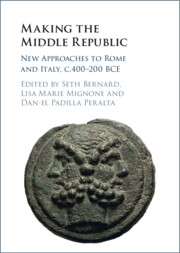Book contents
- Making the Middle Republic
- Making the Middle Republic
- Copyright page
- Contents
- Figures
- Tables
- Charts
- Contributors
- Acknowledgments
- Maps
- 1 Introduction
- Part I Historical Sources
- Part II Material Sources
- Part III Architecture and Art
- 9 No Longer Archaic, Not Yet Hellenistic
- 10 On Architecture’s Agency in Fourth-Century Rome
- 11 Becoming Historical in Oscan Campania
- Conclusion
- Bibliography
- Index
9 - No Longer Archaic, Not Yet Hellenistic
Urbanism in Transition
from Part III - Architecture and Art
Published online by Cambridge University Press: 20 April 2023
- Making the Middle Republic
- Making the Middle Republic
- Copyright page
- Contents
- Figures
- Tables
- Charts
- Contributors
- Acknowledgments
- Maps
- 1 Introduction
- Part I Historical Sources
- Part II Material Sources
- Part III Architecture and Art
- 9 No Longer Archaic, Not Yet Hellenistic
- 10 On Architecture’s Agency in Fourth-Century Rome
- 11 Becoming Historical in Oscan Campania
- Conclusion
- Bibliography
- Index
Summary
The chapter aims to illustrate the transformations that took place in the urban centers of Latium vetus during the 4th and 3th centuries BCE, the chronological period that includes the last, turbulent decades of the political autonomy of the cities of Latium and that sees, after the dissolution of the Latin League, the constitutional redefinition of the subjected communities and their inclusion in the political, military, and economic dynamics of Rome. At the same time, the chapter proposes to evaluate the role of Latin urban culture in the process of Roman expansion in Latium adiectum and in the wider colonial phenomenon: This shows extensive territorial reorganization and newly founded urban centers which are hardly “Roman” and are more related to or derived from the urban Latin tradition (for in terms of settlement principles, spatial organization, use of materials, and construction techniques). The communities of ancient Latium, in fact, must have had a primary role in the process of conquest and “Romanization” of the Peninsula, a process that because of its dynamics, its manifestations, and its outcomes, would be more correctly defined as “Latinization.”
- Type
- Chapter
- Information
- Making the Middle RepublicNew Approaches to Rome and Italy, c.400-200 BCE, pp. 193 - 209Publisher: Cambridge University PressPrint publication year: 2023



